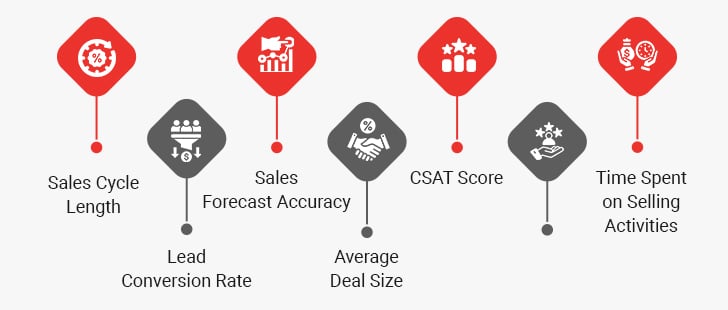Today, companies both large and small alike, are always looking for ways to improve their sales. One way to achieve this is by leveraging the AI capabilities in Salesforce. With Salesforce AI, companies gain useful insights from their data, automate routine tasks, and make smart decisions. AI analyzes customer behavior, predicts future sales trends, and identifies high-potential leads. This helps sales teams focus on what matters most—building relationships and closing deals. AI also automates time-consuming tasks, freeing up sales representatives to spend more time in building solid relations with their prospects and customers.
In this ultimate guide, we will look at the benefits of AI integration in your sales strategy. The guide also delves into the best Salesforce practices for maximizing AI impact in sales. Furthermore, it also features the KPIs to track the effectiveness of integrating AI into sales within Salesforce. Let’s dive in.
Benefits of Salesforce AI Integration for Sales Teams

Source: Salesforce
Listed below are the key benefits that companies harness with AI implementation in sales within Salesforce.
1. Increased Sales Efficiency
Integrating AI in sales makes the process faster and more efficient. AI takes care of repetitive tasks like data entry, lead scoring, and appointment scheduling. This saves time for sales reps, so they focus on important tasks closing more deals. For example, Salesforce AI analyzes customer interactions and automatically prioritizes leads that are most likely to convert. This way, sales teams spend their time on the best leads, increasing their chances of success. With AI handling routine tasks, sales reps also respond more quickly to customer questions, improving overall service. This helps your sales staff be more productive.
2. Enhanced Customer Insights
AI provides useful information about what customers like and how they behave, which is important for any sales representative. By looking at data in Salesforce, AI finds patterns in customer interactions and buying history. This helps sales teams understand what customers exactly want and how they prefer to communicate. For example, if AI finds that a customer often engages with certain products, sales reps may tailor their pitches to match those interests. This personal touch helps close more deals and builds fruitful relationships with customers. Further, better insights allow your company to create targeted marketing campaigns that meet individual needs, leading to happier customers in the long run.
3. Better Sales Forecasting
Precise sales forecasting is important for effective business planning. AI helps by analyzing past data and market trends in Salesforce to predict future sales. With this data, your company determines which products are likely to sell well and which leads are promising. This helps your sales teams use their resources wisely and change their strategies based on expected demand. For example, if AI predicts more interest in a certain product, the sales team focuses on promoting it. Better forecasting helps your company make smart data-backed choices.
4. Better Lead Generation
Integrating AI in Salesforce greatly improves lead generation efforts. AI sifts through large chunks of data to find leads that align with what your company is looking for. For example, by assessing online behavior, AI can score leads based on their possibility to convert. This means sales reps can channelize their efforts on warm/hot leads rather than draining efforts on those less likely to convert. Furthermore, AI takes care of the outreach process by sending custom messages to the right leads at the right time. Better lead generation helps your company utilize its resources smartly and increase conversion rates.
5. Personalized Customer Engagement
AI allows you to connect with your customers in a more personal way. By looking at customer data in Salesforce, AI helps your sales reps craft messages that fit individual preferences. For example, AI may suggest personalized email content based on customers browsing behavior. This level of personalization increases the chances of customers making a sale. When sales reps have detailed information about a customer, they will have more meaningful conversations that meet specific needs.
6. Faster Decision-Making
AI provides sales staff with real-time information that helps them make quick decisions. By constantly analyzing data from different sources in Salesforce, AI keeps you updated on customer activities. This allows sales reps to tailor their strategies based on current trends or feedback from customers. For instance, if a lead shows more interest in a product after receiving an email campaign, the sales team can quickly follow up with relevant information or offers. Quick decision-making helps companies respond faster to changing situations or customer needs.
Maximize Your Sales Performance with Salesforce Sales Cloud
Best Practices for Maximizing AI Impact in Sales
By religiously following these best practices, businesses can maximize the impact of AI in Sales within Salesforce.
1. Focus on Customer Experience
When using AI in Salesforce, the primary goal is to improve the CX. Use AI to assess how customers engage with your business. Also, try to identify their needs and preferences. This helps sales teams offer personalized solutions that build trust. For instance, AI may suggest products based on customers past purchases or browsing behavior. This makes customers feel valued and increases the likelihood of making a sale. Always keep the customer at the center of your AI strategy to forge lasting relationships.
2. Invest in Team Training
To maximize the impact of AI, it is important to train your sales staff on how to use AI tools well. Hold regular training sessions to help them learn about AI features in Salesforce. A well-trained team utilizes these tools to improve their sales strategies. Encourage them to keep learning about new AI updates and best practices so they work more efficiently and make smarter decisions.
3. Monitor and Evaluate Results
It’s important to regularly check how well your sales strategies are working. Set clear goals, like how many leads can potentially turn into customers or how happy customers are. By looking at these numbers, you can see what needs improvement and change your sales strategies if needed. Regular checks ensure that your AI tools are helping you reach your sales goals.
4. Predict Future Trends
Use predictive analytics in Salesforce to uncover hidden trends and patterns. This entails looking at past data to forecast which leads are most likely to convert. By using this data, sales teams focus on leads that have a higher chance of conversion. This makes them work more efficiently and drives conversion rates. Forecasting also helps your company make smart decisions based on data rather than guesswork.
5. Collaborate Across Teams
Encourage different teams to work together when using AI in Salesforce. Sharing information using AI tools leads to better strategies for everyone involved in sales. For example, the marketing team can share data about what customers like, which helps sales teams score leads better. Working together helps everyone use AI more effectively.
6. Gather User Feedback
Listening to feedback from both customers and your sales team is important for maximizing the impact of AI in Salesforce. Sales reps who use AI tools regularly have useful information about what works well and what doesn’t. Regularly collect this feedback to make necessary changes and improve user experience. Being open to change helps your company create a better system that meets the needs of both customers and employees.
7. Stay Updated with the Latest AI Developments
The world of AI is changing fast. Thus, it’s critical for companies to stay updated on the latest AI developments. Allow your staff to explore new AI features in Salesforce. You may also encourage them to participate in AI workshops or training sessions. Staying updated allows your team to use new tools that make your sales strategies more efficient and effective.
The Ultimate Guide to Improve Your Sales Team Through Salesforce Sales Cloud
KPIs to Track the Effectiveness of Integrating AI Into Sales Strategies in Salesforce
Tracking these KPIs helps companies measure the effectiveness of integrating AI into sales within Salesforce.

1. Sales Cycle Length
Sales cycle length refers to the time a lead takes to convert. This KPI helps you understand how quickly you close deals after AI implementation in sales. AI makes several steps in the sales cycle faster, like automating follow-ups and providing insights into customer behavior. A shorter sales cycle means that AI is helping your sales teams respond faster to customer needs. To track this, measure the average time from first contact with a lead to closing the sale. By analyzing changes in this sales cycle length, your company may find ways to improve their sales strategies.
2. Lead Conversion Rate
It shows the percentage of leads that become paying customers. This is an important way to see how well your strategies are working after implementing AI in sales. By tracking this metric, businesses can find out if AI tools are helping sales teams focus on the right leads. A higher conversion rate means that AI is good at finding leads ready to buy. To calculate the lead conversion rate, divide the number of converted leads by the total number of leads and multiply by 100. Checking this regularly helps your company improve its sales efforts and increase revenue.
3. Sales Forecast Accuracy
Sales forecast accuracy measures how closely actual sales match predicted sales numbers. This is important for checking how well AI forecasting tools work in sales. Accurate forecasts help your company plan resources and set realistic sales goals. By looking at past data and market trends, AI gives accurate predictions. To measure sales forecast accuracy, compare actual sales to predicted figures over a certain time and calculate the percentage difference. Monitoring this helps your company improve its forecasting models and make better decisions based on data.
Next-Gen Salesforce: A Closer Look at Generative AI’s Role in Sales and Customer Service Evolution
4. Average Deal Size
Average deal size measures how much money your company makes from closed deals over a certain time. This KPI helps you measure the effectiveness of AI implementation in sales. By using AI for upselling and cross-selling, you are likely to increase the average deal size. To calculate this metric, divide the total revenue from closed deals by the number of deals closed during the same period. This helps you understand if your AI strategies are leading to higher revenue per transaction.
5. CSAT Score
CSAT score measures how happy customers are with your products or services after dealing with your sales team. This score is important for understanding how well your strategies work after implementing AI in sales. By using AI tools to provide timely support or personalize interactions, your company is likely to improve its CAST. To measure this score, send surveys asking customers to rate their satisfaction on a scale of 10. Analyzing CSAT scores helps you find the key areas for improvements in customer engagement and service delivery.
6. Customer Retention Rate
This shows how well a company keeps its customers over time. This is important for knowing how satisfied and loyal customers are, which may be improved with AI. By using AI to analyze customer data, your company better understands its clients’ needs. This leads to improved service and support. A higher retention rate means that AI is helping build stronger relationships with customers. To calculate this rate, subtract the number of customers lost from the total number of customers at the start of a period. Hereafter, divide by the initial number of customers and multiply by 100. Regularly checking this KPI helps you understand how well you engage with your customers.
7. Time Spent on Selling Activities
This shows how much time sales reps invest in selling tasks. The goal of using AI in sales is to reduce time spent on non-selling activities. Higher selling times indicate that AI frees up sales reps for core tasks. This allows them to invest in building customer relationships and close more deals. To track this KPI, measure how much time is spent on different selling activities and look for trends over time.
How Salesforce Professionals Can Use AI to Supercharge Productivity?
Summing Up
Integrating AI into your sales strategy within Salesforce significantly improves your business’s performance. With the help of AI tools, you can make customer interactions more personal, automate simple tasks, and provide useful information about user behavior. This saves time for your sales team, so they focus on building strong relationships with customers. As you implement AI in sales within Salesforce, remember to set clear goals, provide training for your team, and continuously monitor results.





